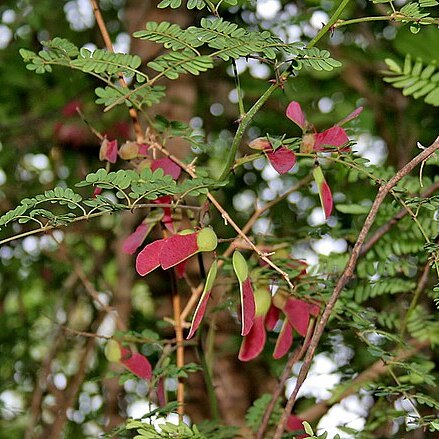Shrubs, normally climbing, armed with prickles on stem and leaves. Leaves bipinnate; stipules small, inconspicuous, soon falling, subulate or triangular-subulate; specialized glands restricted to petiole and rhachis absent; leaflets opposite. Inflorescences of terminal and axillary often paniculately aggregated racemes; bracts small, soon falling. Flowers hermaphrodite. Sepals 5, imbricate, unequal, the lower one cucullately embracing the others; hypanthium cupular, regular. Petals 5, equal or almost so. Stamens 10, all fertile; filaments alternately rather longer and shorter, all pubescent below; anthers dorsifixed, dehiscing by longitudinal slits. Ovary free, very shortly stipitate; ovule 1, attached near top of ovary; style gradually enlarged near apex; stigma transverse, not peltate. Pods resembling the samara of a sycamore (Acer), with a shortly stipitate basal seed-containing portion (with a single seed) whose upper suture is much prolonged beyond the seed-containing part of the pod and is broadly winged on its lower side, the wing usually becoming wider distally. Seed pendulous, ± compressed, without endosperm.
Shrubs, climbing, tall, or woody climbers. Branches with recurved prickles. Leaves abruptly bipinnate, alternate; pinnae and leaflets numerous; stipules and stipels caducous, small or obscure. Racemes or panicles axillary or terminal; bracts caducous, subulate to linear. Flowers whitish or yellowish, small; bracteoles absent. Receptacle discoid. Sepals 5, imbricate, lowermost navicular, larger, emarginate. Petals 5, spreading, oblong or obovate, slightly unequal, with imbricate sepals. Stamens 10, free, subequal, declined; filaments sometimes villous at bases; anthers uniform, cells opening by lateral slits. Ovary sessile, ovoid, inserted at base of receptacle, free, 1-or 2-ovuled; style short or elongated and clavate at apex; stigma terminal, truncate or concave. Legume sessile, compressed, samaroid, indehiscent, upper part produced into an oblique oblong or falcate, membranous wing. Seed pendulous at apex of locules, without endosperm; cotyledons flat; radicle short, straight.
Pods resembling the samara of Acer species with a basal, ± broadly elliptic, sometimes slightly inflated, seed-containing portion, extending obliquely on the upper margin into a broad wing usually 2–4 times as long as the basal part, the style sometimes persistent for a short time at the apex; seed solitary, compressed, without endosperm.
Flowers smallish, in ± dense many-flowered terminal and lateral racemes often grouped into panicles; bracts inconspicuous.
Ovary subsessile; stigma transversely flattened, not peltate; ovule 1, attached towards distal end of ovary.
Stamens 10, all fertile, alternately longer and shorter; filaments pubescent in the lower part.
Leaves bipinnate; petiole and rachis without specialised glands; leaflets opposite.
Sepals 5, imbricate, the lower one curving upwards over the others.
Shrubs, usually climbing, armed with prickles on stem and leaves.
Flowers hermaphrodite, with a small receptacular disc.
Petals 5, subequal.

